Motion Offense Principles versus Zone Defence
Motion Offense versus a zone defence is one of the most effective ways to produce scoring opportunities without relying on set plays. The strength of the motion offense against a zone defence is in the ability for scoring prospects to happen from reads, rather than looking for a particular shot, at a specific period of time from a structure offense.
Motion offense when based upon reading what the defence allows will eventually lead to the right shot at the right time. The scoring opportunities your team can look for can be drilled and game scenarios explored to help establish what the “right shot” looks like for each individual player from each position on the floor.
In a motion offense the ball can be passed and moved from one side of the floor to the other without this affecting the scoring options. Motion offenses are continuity offenses which means they can be run indefinitely. As a coach it is however important when using motion offense for your team that you allow ample time for the players to develop the offensive awareness required to be inconstant motion always looking for opportunities from spacing and timing, not necessarily from the “play” itself.
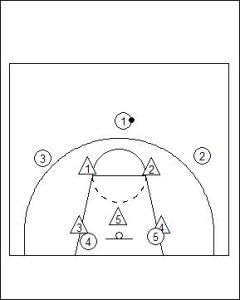
There are many zone offenses available today but the motion offense rules that coaches are all teaching their juniors can be utilised to breakdown a zone defence.
Several principles need to be used in order to obtain the best results and they are;
- attack the seams/gaps
- dribble and pass penetration
- move the zone/distort the zone
- screen the zone
- skip pass and reversals/cross split line
- dribble one way, pass the other
- your alignment
This is often called “odd guard front”.
Your baseline players must be “deep” at least at the level of the backboard.
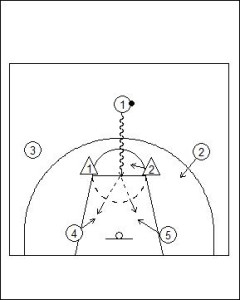
GAP DRIBBLE (ATTACKING THE GAP)
With this penetration you are looking to attack the gaps of the zone in order to have one or both defensive players sag in to defend/stop the ball.
When this occurs an open man is created for the shot and in this situation we must look for the big players inside.
At any penetration like this you want two feet in the paint and the player to land strong on a jump stop.
In Diagram 1 attacks the gap and defender Two (2) tries to stop the dribbler, in this instance the dribbler is trying to find the inside players (Four and Five).
The inside players look to step inside to receive the ball and seal the defence.
This type of penetration is not restricted to the point and can be achieved form the wing/sides of the zone.
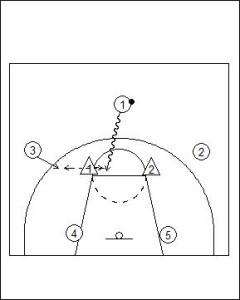
FREEZE DRIBBLE (ATTACKING A MAN)
Another useful form of penetration tactic is to “freeze” the defence, this is done by attacking one defender via dribble penetration.
The dribbler must attack the inside shoulder (furthest shoulder from the point you wish to pass to. i.e. passing to the right the dribbler must attack the left hand shoulder of defender One) in order to commit the defender and create the opening via distorting the alignment.
With the freeze dribble we are usually creating a shot for the perimeter players.
Like with attacking the gap the freeze dribble can be just as effective form the wing/side of the zone.

DRIBBLE ENTRY (POINT TO WING)
Another way of creating movement in the zone is via a dribble entry.
If you dribble enter from the point to the wing you can make the zone move to create space on the weak side of the floor.
One (1) dribble enters to the wing, Three (3) shallow cuts to fill the open space left by One (1).
In this situation the zone will move towards the ball side of the floor thus creating space for the open shot via a quick reversal or skip pass to offensive player Two (2).
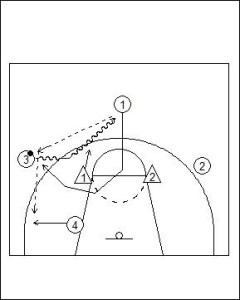
DRIBBLE ENTRY (WING TO POINT)
When a ball side has already been created then a dribble entry from the wing to the point will create a scoring opportunity at the short corner or low post extended on the same side of the floor.
Offensive player Three (3) will dribble at the top defender (One) to commit the defence then continue on to the point, as offensive player One (1) shallow cuts and replaces Three (3) at the wing.
As this has caused a shift in the zone then a quick pass back to Three (3) may create a shot but the better option would be to have Four (4) step out from the post (as his defence should now have sagged back into the paint) and look for the shot.
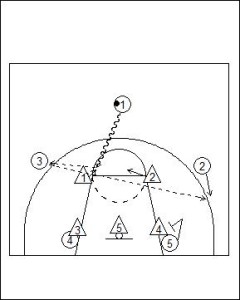
SCREENING THE ZONE
Screens against the zone are a very effective way of creating a shot opportunity.
In order to have players screen a zone it must be enforced that the screens occur early, either within the first or second pass as a golden rule.
One (1) freeze dribbles at the defender and passes off to Three (3) this will cause defender Two (2) to sag in.
Offensive player Two (2) cuts down to the mid post extended area while offensive player Five (5) screens the defensive player (Four) to stop them from coming out to the ball.
If the defence does fight over (Four) then Five (5) will step in and re-screen and seal on the Five (5) defender for the inside pass from Two (2).
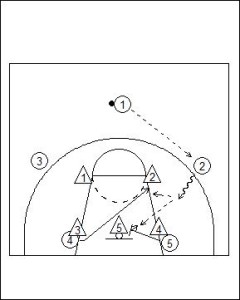
INSIDE PLAYER MOVEMENT
When the ball is passed to the wing the weak side player flashes to the strong side high post (Four).
The strong side low post player (Five) seals the defensive player on the inside of the zone.
The offensive wing player looks to drive and either gap or freeze dribble to execute the pass.
One repeated ball reversal, interior players move from high to low, crossing to opposite position on the other side of the split line.








Leave a Reply